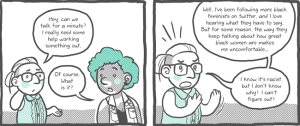They say imitation is the highest form of flattery. What happens when it’s not so flattering?
The more you learn about the world and the people in it, you quickly realize just how beautiful and diverse it is. Where’s the line between cultural exchange, appreciation, and appropriation? Why does it even matter? Here’s seven myths about cultural appropriation debunked.
1. ‘You’re just looking for something to be offended by. It’s just clothing, hairstyles, decorations, whatever. Don’t you have something better to worry about?’
Okay. First off, it’s possible to care about more than one issue at a time.
The main problem with cultural appropriation comes from dominant groups “borrowing” from marginalized groups, who face oppression or have been stigmatized for their cultural practices throughout history. Like, cornrows. I mean, anyone can wear their hair in cornrows, but black people still face stigmas for wearing them, along with perfectly natural hairstyles like braids and locs. There are even companies and schools that prohibit these natural hairstyles. People have actually been fired for wearing braids.
Meanwhile, fashion models and celebs like Kylie Jenner get praise for wearing corn rows, and that’s the main point. One group is being penalized by institutions for wearing natural hairstyles, where the other is called edgy and stylish for doing the exact same thing.
2. ‘I’m doing it because I think it’s beautiful and exotic. I’m just showing appreciation for the culture.’
Look, it’s great that you find another groups culture beautiful. In order to show you truly love it, you need to have respect and understanding. Take for example, tribal tattoos. The Maori of New Zealand have facial tattoos with deep family meaning and cultural significance, but fashion designer Jean Paul Gaultier used the tattoos in ads to sell sunglasses.
Now, that’s a perfect example of cultural appropriation. No matter how much the designer liked the look, he stripped the tattoo of all of it’s cultural meaning, just to sell a product. Now, if you really appreciate something, you should respect it instead of assuming you can use it however you want.
3. ‘Well, I don’t find it offensive, and I asked someone from that culture, and they said it was okay.’
Well, it’s not your culture that’s being disrespected, so sure, you don’t find it offensive. If you know someone from that background who doesn’t mind your tattoo, costume, or whatever, that’s cool. Remember that one person doesn’t speak for all members of that community.
4. ‘Whatever. Fashion, art, film, music always borrows from other sources. Plus, it doesn’t hurt anyone.’
Sure, cultural exchange has been going on since the beginning of time, but exchange is mutual. It needs to be done respectfully. A couple years ago, Katy Perry did a Geisha-themed performance with Japanese women dancing in the background. Not only was it super stereotypical, her outfit wasn’t even from the right country.
The Japanese American Citizens League said it best: “The thoughtless costuming and dance routines by Katy Perry played carelessly with stereotypes in an attempt to create a Japanese aesthetic.” That kind of crushes the idea of an appropriation as harmless.
5. ‘You’re just trying to tell everyone what to think. Hello, thought police! Have you ever heard of the first amendment?’
Nobody’s telling you what to think, wear, or say. Marginalized people can’t stop you from doing your thing, even if they wanted to. But if you think you have the right to use any cultural tradition just because, that’s where you get into oppressive territory. If you genuinely don’t care if someone is hurt by your appropriation, that’s just crappy.
6. ‘Because I’m white, I’m automatically racist, and if I wear this clothing, I’m even more racist?’
This isn’t about beating up on white people. Anyone can appropriate elements of marginalized cultures. Heck, Pharrell even made the mistake of wearing a Native American headdress on the cover of Elle magazine. After getting some much deserved flak, he actually issued an apology.
7. ‘If Chinese people wear blue jeans, aren’t they appropriating my culture? What about black girls wearing blonde weaves? How about speaking English?’
Okay, this is a tough one. Assimilation and appropriation aren’t the same thing. Marginalized people conforming to standards set by dominant – or in this case, Western cultures – is often a means of survival. When your cultural heritage is looked down on, often people change or hide things about themselves in order to be accepted by majority culture.
For example, there are schools where students have been punished or even suspended for speaking Spanish or indigenous languages. There are people who are literally being forced to assimilate or else, so it’s not really a fair comparison.
“So you’re saying I should never enjoy another culture? That’s not fair.”
Not at all. For example, say you’re invited to an Indian wedding, and you’re not Indian. Wearing a traditional sari or getting henna would be a great example of cultural exchange. You’re being invited to participate and enjoy the culture, instead of just picking and choosing parts of it for yourself.
You can also travel, take cooking classes, read books, listen to music, and visit museums if you really want to learn about and enjoy other cultures.
***
Here’s the thing: Cultural appropriation is about a privileged group misrepresenting and disrespecting marginalized cultures. The originators rarely get credit, but always deal with the consequences. The goal isn’t to shame you out of wearing or enjoying certain things, but listening to the people from the culture you’re interested in, shows you have a genuine love, respect, and understanding for something that’s not your own.
What are some misconceptions you’ve heard about cultural appropriation? Maybe your had some misunderstandings, yourself. Tell us in the comments below, and we’ll see you next week here on Decoded.




















